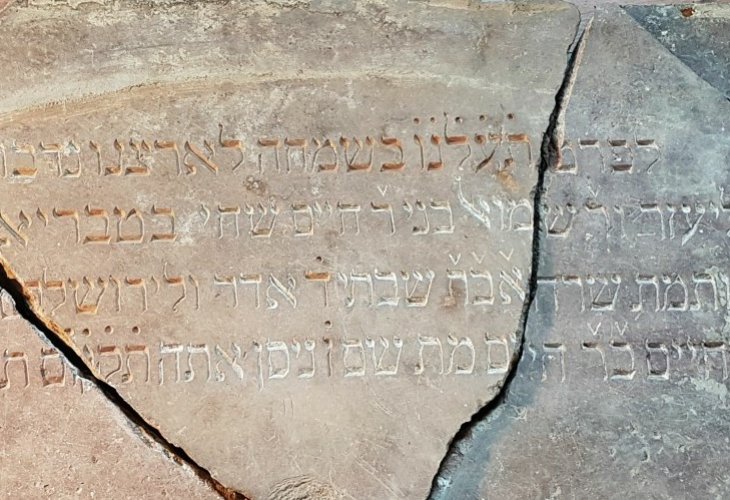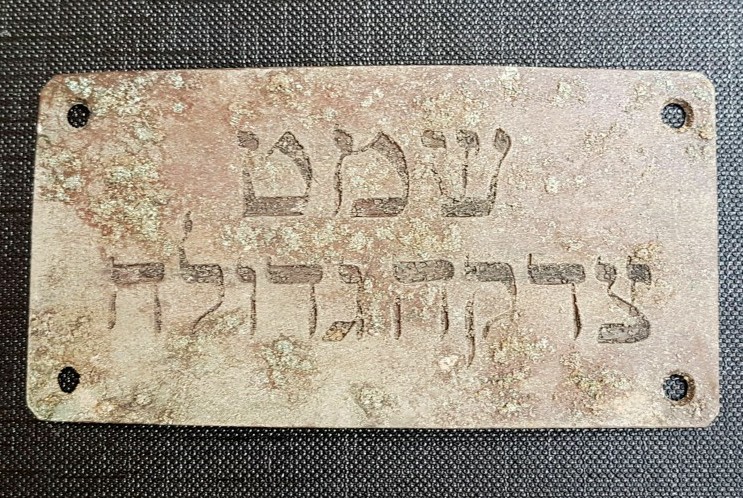Remarkable Find: Hebrew Inscriptions Unearthed at Vilna Synagogue Excavation
In a significant discovery at the Vilna Great Synagogue excavation site, researchers have uncovered ancient Hebrew inscriptions for the first time since the synagogue was destroyed by the Nazis. One of these inscriptions was part of a stone table used to read from the Torah. Join us in exploring this fascinating piece of history.
 The shattered inscription from the synagogue bimah (Photo: Yochanan (John) Zeligman, Israel Antiquities Authority)
The shattered inscription from the synagogue bimah (Photo: Yochanan (John) Zeligman, Israel Antiquities Authority)The excavation project aimed at uncovering the Vilna Great Synagogue, which was burned during the Holocaust and later demolished by the Soviets, continues to reveal exciting glimpses into the Jewish heritage of the city once known as the "Jerusalem of Lithuania." For the first time since the project began, Hebrew inscriptions have been found at the site.
The excavations, conducted every summer for the past four years, are led by Dr. Yochanan (John) Zeligman of the Israel Antiquities Authority and Justinas Račas of the Lithuanian excavation company. According to them, "The significant inscription, originating from 1796, combines verses from Genesis and Psalms, and was part of a stone table used for reading the Torah, situated on the synagogue's grand bimah."
The researchers have managed to reconstruct the shattered inscription parts. From the text, it is revealed that the table was donated by two brothers, Rabbi Eliezer and Rabbi Shmuel, in memory of their parents, Sara and Rabbi Chaim. The inscription indicates that Rabbi Chaim emigrated from Lithuania to the Land of Israel, settled in Tiberias, and passed away in Jerusalem. This table was used for Torah reading for nearly 200 years, until the synagogue was burned and ultimately destroyed.
 A fragment of the inscription held by a member of the excavation team (Photo: Yochanan (John) Zeligman, Israel Antiquities Authority)
A fragment of the inscription held by a member of the excavation team (Photo: Yochanan (John) Zeligman, Israel Antiquities Authority)The inscription, read with Dr. Vladimir Levin from the Hebrew University in Jerusalem, states: "For 'Te'alnu' (year 1796) with joy to our land. Donated by Rabbi Eliezer and Rabbi Shmuel, sons of Rabbi Chaim who lived in Tiberias (tuvv) and (hiyyash) the soul of Sara, whose father was Rabbi Shabbtai, 4th Adar, and to Jerusalem 'Mevaser' (year 1782) gives, and 'Rise' (year 1786) will comfort Zion."
According to the researchers, "These brief sentences highlight the deep connection between the Lithuanian community and the Holy Land, a bond persisting since the days of the Vilna Gaon until today. An initial inquiry shows that the donating family was among the leading rabbinical families in Lithuania in the early 18th century." They add that due to the absence of the donors' family name in the inscription, the information is incomplete, inviting the public "to contribute additional pieces to the puzzle and provide information about the family."
An additional personal memento discovered is the seat plaque of the head of the 'Great Charity' association, which managed the Vilna Great Synagogue from the late 18th century until 1931. "These discoveries are particularly captivating: personal items that offer a direct link to the individuals who prayed here. It immediately sparks the imagination," say Zeligman and Račas.
 Seat plaque of the head of the 'Great Charity' association (Photo: Yochanan (John) Zeligman, Israel Antiquities Authority)
Seat plaque of the head of the 'Great Charity' association (Photo: Yochanan (John) Zeligman, Israel Antiquities Authority)The excavation of the Great Synagogue in Lithuania is a joint venture of the Israel Antiquities Authority, the Lithuanian excavation company, the Good Will Foundation, and the Jewish community of Lithuania. Israel Hasson, director of the Israel Antiquities Authority, notes that "The project to uncover Vilna's ancient synagogue is part of the 'Heritage Without Borders' concept of the Israel Antiquities Authority. It involves excavating and documenting sites outside Israel that have significant heritage value in the history of the Jewish people, as part of the belief that the authority is entrusted by the public in Israel to serve as their 'heritage watchman' for cultural assets."
The ancient Vilna synagogue was constructed in the 17th century and served as the "beating heart" of Lithuanian Jewry. It was situated at the hub of a vast complex of Jewish community buildings in Vilna, including about 20 synagogues and study halls, ritual baths, a community center, the renowned Strashun rabbinical library, and the synagogue of the Vilna Gaon, Rabbi Elijah of Vilna.
Before World War II, about one-third of Vilna's 60,000 residents were Jewish. When Germany occupied Lithuania in June 1941, the Nazis began their systematic extermination of the Jewish population. They burned and partially destroyed the Great Synagogue. The Soviets, who reoccupied Lithuania in the autumn of 1944, completed the vile task. A kindergarten, later turned into a school, was built over the synagogue's remains in the 1950s.
In recent years, archaeological excavations have been undertaken in Vilna to restore the city's old quarter. Gradually, discoveries are being made of Vilna's Jewish past. In summer 2015, a ground-penetrating radar survey revealed the remnants of the ancient synagogue buried beneath the school, possibly including ritual baths. Two mikvahs were uncovered there two years ago. Excavations in the past two years have revealed significant portions of the synagogue bimah. The magnificent bimah, which stood two stories tall, was constructed in the 18th century with funds donated by a Jewish philanthropist known as Yesod. Documented in early 20th-century photographs, the decorated bimah was an impressive structure with four grand columns supporting the ceiling. This year, components of these columns were found, along with the bimah front where the Torah reader read for 200 years.
Another interesting find is the grand and colorful bimah floor. Beneath the bimah, researchers also discovered a previously unknown cellar. Additionally, a surviving siddur from the Holocaust, hundreds of coins dating from the 16th to the 20th century, and buttons from Napoleon's army, which passed through Vilna during its ill-fated Moscow campaign in 1812, were unearthed.
The researchers conclude that "The discovery of the synagogue's column foundations, central bimah parts, and inscriptions attests to the exciting potential of further excavations and the possibility of publicly showcasing the remains of the Vilna Great Synagogue and its courtyard (the Shulhoyf) to both local and international audiences."
(Video by: Loïc Salfati)

